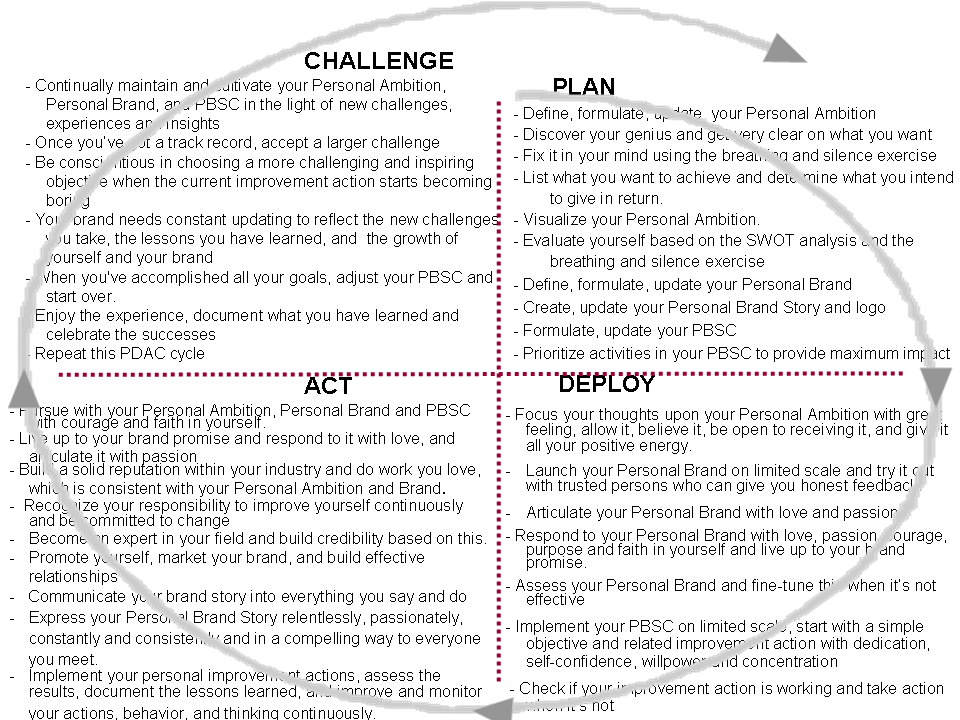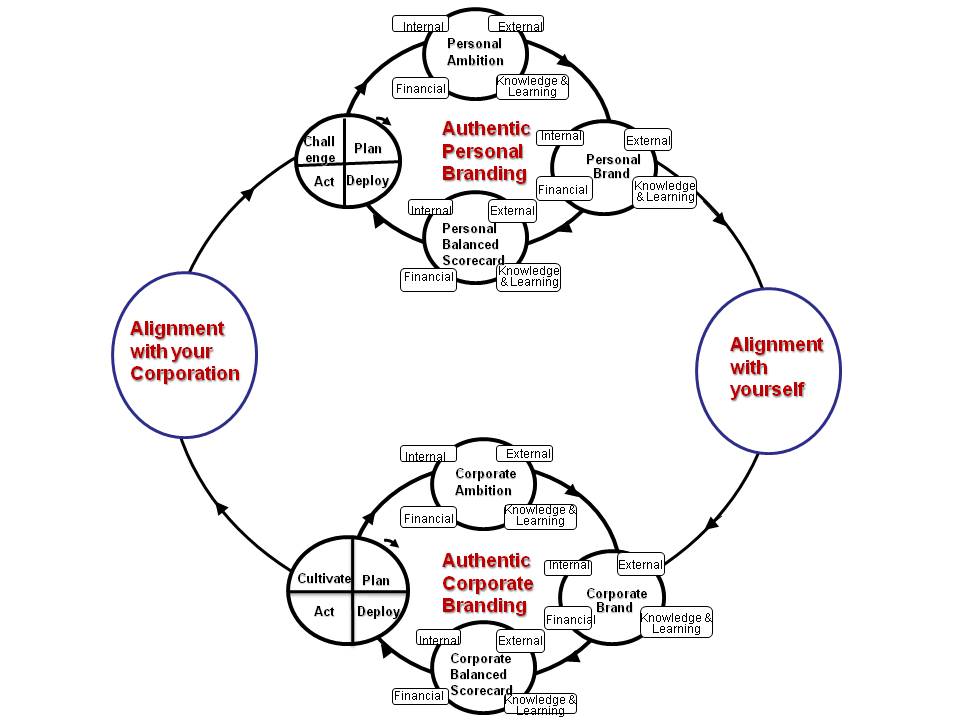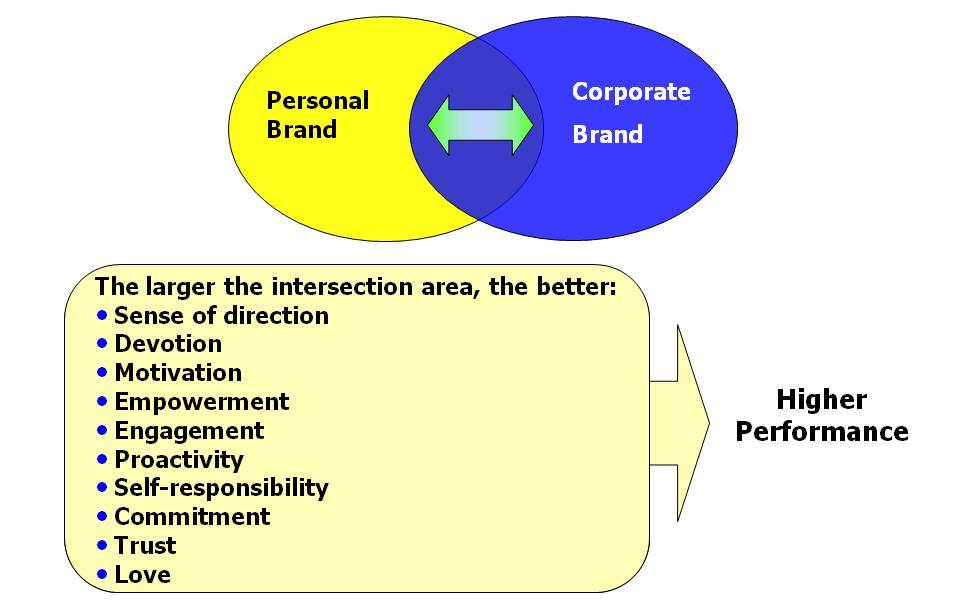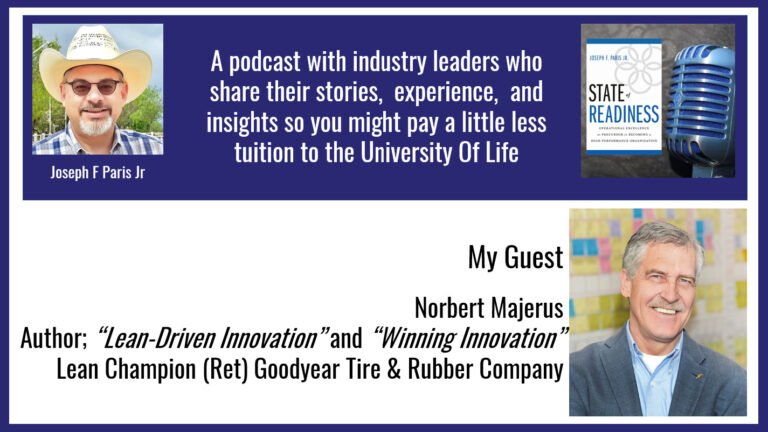Aligning Personal Brand with Corporate Brand
Increasingly, successful companies are beginning to recognize that good brand relationships with their employees are more important than good brand relationships with their customers. They understand that employees should be happy first in order to make the customers happy and that corporate brand loyalty starts with employee’s engagement. This can be realized by aligning the employee’s brand with the corporate brand. This article proposes a successful method to realize this.
Alignment is needed, because staff members don’t work with devotion or expend energy on something they do not believe in or agree with. If there is an effective match between their interests and those of the company, or if their values and the company’s values align, they will be engaged and work with greater commitment and dedication towards realizing the company objectives. Identification with the corporate brand is the most important motive to dedicate themselves actively to the corporate objectives and to maximize their potential. When your personal brand is compatible with your corporate’s brand and combined in the best interest of both parties, the results will be higher brand equity, brand loyalty and happy stakeholders. Doing work related to your personal and corporate brand that is interesting, exciting and provides learning opportunities has become a key personal driver. The emphasis here lies in intrinsic motivation. Intrinsic motivation is inherently pleasurable and it arises from within; most people do something because they enjoy doing it and love it. People work harder and better when they perceive that they are treated as human beings and when they do interesting and challenging work.
Aligning personal brand with the corporate brand has an impact on the organizational bonding of the employees. This energizes them and gives them the proud feeling that they count, that they are appreciated as human beings and that they make a useful and valuable contribution to the organization. Employees are stimulated in this way to commit and focus on those activities that create value for clients. This will create a strong foundation of peace and stability upon which creativity and growth can flourish, and life within the company will become a more harmonious experience. This has an important impact on employee engagement. Lack of engagement is endemic, and is causing large and small organizations all over the world to incur excess costs, under perform on critical tasks and create widespread customer dissatisfaction.
The impact of engaged, happy and passionate employees on the company performance can be illustrated with the following important research data. There are 22 million actively disengaged employees in America, according to Gallup (Gallup Poll, 2005). Their dissatisfaction is manifested in employee absence, illness, and a variety of other big and small problems that occur when people are unhappy at work. Gallup statistics show that unhappy workers cost the American business economy up to $350 billion annually in lost labor productivity, and that earnings per share increase 2.6 times more if employees are engaged. Active engagement of employees in their jobs and work is mandatory if U.S. businesses are to enjoy high productivity in our global economy. However, research indicates that 70% of U.S. employees are not engaged at work (Hymowitz, 2007). Companies with such a large number of dissatisfied employees “have more absenteeism and lower labour productivity — as well as 51% higher turnover rates than those with engaged employees”, says James Harter, chief scientist for Gallup’s international management practice. Employee disengagement is a global epidemic. According to the latest Gallup poll information:
- 61% of the British workforce, 67% of the Japanese workforce, and a whopping 82% of the workforce in Singapore is not engaged.
- Disengaged employees cost Singapore $4.9 Billion; the country’s workforce ranks among the lowest in the world in employee engagement.
- 20% of Australian workers are actively disengaged at work and this costs the economy an estimated $31.5 billion per year; the survey of 1,500 Australian workers found that only 18% are engaged at work and thus providing their employers with high levels of productivity, profitability and customer service.
- The percentage of engaged employees in organizations is less than 20% in Europe.
- The highest recorded levels of engaged employees are in Brazil (31%) and Mexico (40%). The lowest recorded levels are in Asia.
The average U.S. worker wastes more than two hours a day (that’s not including lunch) according to a new Web survey by America On-line and Salary.com. That means companies spend as much as $759-billion on salaries annually for which they receive no apparent benefit. Our own research indicates that no organization is free of the issue. But what is being done about it? In the next section I will introduce an advanced breakthrough model to build, implement, cultivate and align an authentic, distinctive, relevant, and memorable personal and corporate brand, which forms the key to a highly engaged and happy workforce.
An Authentic Personal & Corporate Branding Model
I am including below a holistic blueprint and roadmap to help you in formulating and implementing an authentic personal and corporate brand identity that is in line with yourself and with your company. This organic model consists of the following four phases (see Figure 1), which are the building blocks of a strong personal and corporate brand (Rampersad, 2009):
- Authentic personal branding: This phase involves defining, formulating, implementing and cultivating your authentic personal ambition, brand, and balanced scorecard. – Published in our August eNewsletter edition – Click Here
- Alignment with yourself; your personal brand should reflect your true self and must adhere to a moral and behavioral code set down by your personal ambition. This means that who you really are, what you care about and your passion should come out in your brand. You should act and behave accordingly to build trust.
- Authentic corporate branding: This phase involves defining, formulating, implementing and cultivating the corporate ambition, brand and balanced scorecard.
- Alignment with your corporation; the final step entails aligning and synchronizing the employee’s brand with the corporate brand for the purposes of employee engagement and creating a challenged and happy workforce.
Figure 1: Authentic Personal and Corporate Branding Model (Rampersad, 2009)
In the following sections, each of the phases in the model will be discussed in depth.
Authentic Personal Branding
Building an authentic personal brand is a journey and an evolutionary process. It starts with determining who you are at your core authentic self, which is based on your dream, vision, mission, life philosophy, values, key roles, identity, self-knowledge and self-awareness. Your personal brand should emerge from your search for your identity and meaning in life; it is about getting very clear on what you want, fixing it in your mind, giving it all your positive energy, doing what you love and develop yourself continuously.
This step in the model consists of the following four phases:
- Define and formulate your personal ambition; this phase involves defining and formulating your personal ambition in an exciting and persuasive manner and making it visible. Your personal ambition is the soul, starting point, core intention and the guiding principles of your personal brand. It’s the fuel for your brand and encompasses your personal vision, mission, and key roles, related to four perspectives, that should be in balance: internal, external, knowledge & learning, and financial perspectives. Mission is aimed at being and vision at becoming. It is about identifying yourself and figuring out what your dreams are, who you are, what you stand for, what makes you unique and special, why you are different than anyone, what your values are, and identifying your genius. You are almost twice as likely to accomplish your brand if you write this down. Formulation is critical to building a strong brand. So take the time to think about your life and to write down your personal ambition statement, which includes your dream. Barack Obama’s dream is: Bring about real change, change that we can believe in. He identified and leveraged his dream, responded to it with love and passion and succeeded by living according to it. My personal mission statement is: Enjoy the freedom to develop and share knowledge, especially if this can mean something in the life of others.
- Define and formulate your personal brand; this phase involves defining and formulating an authentic, distinctive, relevant, and memorable personal brand promise, and using it as the focal point of your behavior and actions. First of all, perform a personal SWOT analysis and define what you want your personal brand to accomplish.You also need to determine your specialization, concentrating on a single core talent, your main specific services, key characteristics, single leading and most powerful attribute, audience and what their greatest needs are. Your personal brand statement also includes your Unique Value Proposition. The next step in this stage is to define your personal brand story (Elevator Pitch), which is the essence of what you want to say about your personal brand in order to produce a positive emotional reaction. Finally you should design your personal logo, which is a single graphical symbol that represents your personal brand. My personal brand statement is: Passionate and compassionate to inspireteachable individuals to unlock their potential and dedicated to energize innovative organizations within the service and manufacturing industry. Using my holistic insight and innovative Total Performance Scorecard principles, I promise to help my customers to realize their dreams. It summarizes me. I have formulated this for myself to be used as guidance for my Personal Brand story and to keep me moving in the right direction.
C. Formulate your Personal Balanced Scorecard (PBSC); your personal personal brand has no value unless you take action to make them a reality. Therefore the emphasis in this stage is developing an integrated and well balanced action plan based on your personal ambition and personal brand to reach your life and brand objectives and to eliminate any negative elements. It’s about translating your personal brand into action. Your PBSC entails your personal critical success factors that are related to your Personal Ambition and Brand and the corresponding objectives, performance measures, targets and improvement actions. It is divided into the four perspectives: internal, external, knowledge & learning, and financial perspectives. Your PBSC translates your personal ambition and personal brand into manageable and measurable personal objectives, milestones and improvement actions in a holistic and balanced way (Rampersad, 2006). Your PBSC is needed to improve and manage yourself continuously. It’s an effective tool that you can use to manage and master yourself and your brand.
D. Implement and cultivate your personal brand; your personal brand has no value unless you implement it to make it a reality. Therefore, the next step is to implement, maintain and cultivate your ambition, brand and PBSC effectively. You have to articulate your personal brand with love and passion, be committed to change, and improve your perceived value in the marketplace and yourself continuously. In addition, try to build credibility and become an expert in your field. Get the word out through a variety of media channels, do work you love which is consistent with your personal brand and values, gain experience in areas of your brand in which you are weak, promote yourself, market your brand frequently and consistently, make conscious choices about the people you associate with, build a strong network, deliver on your brand promise, and in short live according to your brand promise. To guide you in this process I have introduced a unique learning cycle called the Plan-Deploy-Act-Challenge cycle (see Figure 2), which should be followed continuously. This is necessary to let your brand awareness grow gradually. You need to refine your Personal Brand promise as you go along, figuring out which parts work and which don’t, and make adjustments as necessary. You should continually refine your brand promise in the light of new insights, challenges and experiences. There will always be competing brands ready to fill any gap you leave behind. The more you strengthen, maintain, protect and cultivate your brand, the more successful you’ll be. It needs constant updating to reflect the new challenges you take, the lessons you have learned and the growth of yourself and your brand.

Figure 2: The Plan-Deploy-Act-Challenge Cycle (Rampersad, 2009)
Alignment with Yourself
Having a great personal brand identity can make you a big looser if your personal brand doesn’t reflect your true character and if you don’t deliver on your related promise. Not delivering on your promise is a secure way to ruin your reputation and career. So commit yourself to live and act according to your authentic brand promise and be careful to ensure that you can deliver. If you don’t do this, personal branding will be cosmetic, selfish, egocentric and a dirty greedy business. People relate to you as your word and how you fulfill on that. If you say you will do something, you should do that with no excuses. Each time you make or break a promise you are affecting your personal brand image. You should also keep promises that you make to yourself. If you break a promise to yourself you will not have inner peace and will not develop personal charisma and transparency, which will affect your personal brand. You have to live your values consistently on a day-to-day basis and show transparency and accountability. A personal brand built on lies will crash (truth always comes out), and a brand built on the person’s true character is sustainable and strong. To borrow Dwight Eisenhower’s words: a person that values its privileges above its principles soon loses both.
By aligning your personal brand with yourself you will create a stable basis for your trustworthiness, credibility and personal charisma. Who you really are, what you care about and where your passions lie should come out in your brand, and you should act and behave accordingly (you should be yourself) to build trust. Trust will be built faster when others believe you are real, when they witness you being true to your beliefs and aligned with who you really are. You will build trust when your values connect to your attitudes and actions and when you will be true to yourself. The result of this brand building process is a personal brand identity that is not a not fake, not cosmetic, not an ego trip, not selfish, not focused on just promoting yourself, and not a dirty business.This inner alignment is an important step towards lasting personal growth and reinforcing integrity, honesty, trustworthiness, credibility, transparency, and personal charisma.People with this perspective on life value others’ lives and create a stable basis for others to feel they are credible, truthful and trustworthy. They:
- Practice what they preach.
- Keep their word; their actions match their words and their personal brand.
- Keep their brand promises; there is consistency between their personal brand and their behavior.
- Do what they said they would do, despite the obstacles.
You should reflect during this alignment process on the following questions:
- Do I act in accordance with my conscience and my values? Is there consistency between what I am thinking and what I am doing?
- How do my ideals, ambitions, intentions, needs, deepest desires and personal brand fit my present actions?
- Are my thoughts and my practices the same? Do I act consistently in accordance with my personal brand? Does my personal brand reflect my desire to act ethically? Are there contradictions in my personal ambition and personal brand?
- In what way does my behavior influence my views, and vice versa? Do I keep promises that I make to myself? How do others perceive me and my values? Do they witness me being true to my core beliefs and me staying in alignment with who I really am?
The best way to look at success is to ask:
- Have I followed my conscience consistently?
- Have I followed my personal brand consistently?
- Have I given it my best effort consistently?
- Have I done what was right consistently?
Authentic Corporate Branding
This section emphasizes on corporate branding that has a similar base as the authentic personal branding process. This process consists of the following four phases:
A. Define and formulate the corporate ambition; this phase involves defining and formulating the shared corporate ambition. The corporate ambition is the soul of and the fuel for the corporate brand. It encompasses the corporate vision, mission and core values related to the four perspectives, which should be in balance. As with the personal ambition, the following 4 basic perspectives have been chosen, however, the contents have different meanings: internal, external, knowledge & learning, and financial perspectives. A successfully formulated corporate ambition shows employees how their activities contribute to the larger whole. In an organization without a corporate ambition, employees are exposed to ad hoc decisions and short-term plans. The corporate ambition functions as a lighthouse keeping the company steadily on the course of its dream.
- Define and formulate the corporate brand; this phase involves defining and formulating an authentic, distinctive, enduring, and memorable corporate brandpromise, which is in harmony with the corporate ambition and used as the focal point of company’s culture and actions. As with the personal brand, first of all you should perform a company SWOT analysis and evaluate the performance and culture of the company. This relates to the corporate brand objectives. The company shouldalso determine its specialization, what its main specific services are, what its most powerful attribute is, and what its audience (domain) and their greatest needs are. The corporate brand statement entails the total of corporate ambition, brand objectives, specialty, service, dominant attribute, and domain. It also includes a Unique Value Proposition (UVP).
JVC’s Brand Statement
The Perfect Experience
To create truly moving experiences and provide total satisfaction for our customers. Using our superior technologies to create new products, JVC promises to:
- Inspire people
- Expand the possibilities for creative expression
- Provide customers with the potential for personal enrichment
- Provide customers with a lifetime of satisfaction
B. The next step is to define the corporate brand story (Elevator Pitch), which is the essence of what you want to say about the corporate brand in order to produce a positive emotional reaction. Finally you should design the corporate logo, which is a single graphical symbol that represents the corporate brand.
C. Formulate the Corporate Balanced Scorecard (CBSC); as with the PBSC, the emphasis in this stage is developing an integrated and well balanced action plan based on your corporate ambition and brand to reach the corporate objectives. The CBSC entails the related company critical success factors, objectives, performance measures, targets and improvement actions. It’s divided into four perspectives: internal, external, knowledge & learning, and financial perspectives. The CBSC is needed to improve the business processes continuously based on the corporate ambition and brand in order to satisfy its customers and to make them happy.
D. Implement and cultivate the corporate brand; you need to implement your corporate brand to make it a reality. Therefore, the next step is to implement, maintain and cultivate the corporate brand identity effectively in order to deliver peak performance and to create competitive advantage. To guide you in this process I have introduced the Plan-Deploy-Act-Cultivate cycle (PDAC cycle), which should be followed continuously. This is necessary to let the corporate brand awareness grow gradually. Once you implement and launch the corporate brand, it should be maintained continuously. The more you strengthen, maintain, and cultivate the corporate brand, the more successful the company will be. To operate in accordance with the corporate ambition, brand and related CBSC, through its implementation using the PDAC cycle, results in a journey towards business success.
Alignment with your corporation
By aligning and synchronizing employee’s ambition and brand with their corporate ambition and brand you can realize the ‘best fit’ between employee and company.Matching the personal brand with the corporate brand has to do with reaching a higher degree of compatibility between personal and corporate objectives and mutual value addition (as shown in Figure 3). A study, by CO2 Partners (2007), found that 30% of US workers values mismatch with the company:
- One in three U.S. workers said their employer’s core values are not consistent with their own.
- 44 per cent said their values were consistent.
- 11 per cent said they were uncertain about their own core values but never uncomfortable working for their employer.
- 10 per cent said they didn’t feel their core values had much connection to the work they do.
Another study, by Towers Perrin (2005), found that instead of matching the right employee to the right position for long-term success, most US companies and H/R departments put the emphasis on simply filling the position as quickly as possible. As a result, American businesses are losing money as fast as they are losing employees.
It has become essential to get the optimal fit between the personal brand and the corporate brand in order to enhance labor productivity and to stimulate engagement, commitment, love, and passion in the company. This has to do with reaching a higher degree of compatibility between personal and organizational objectives and mutual value addition. People do not work with devotion or expend energy on something they do not believe in or agree with. Clarity and uniformity of personal and organizational values and principles are therefore essential for the active involvement of employees. A study by Towers Perrin (2005), found that while many people are keen to contribute more at work, the behavior of their managers and culture of their organizations is actively discouraging them from doing so. It shows that there is a vast reserve of untapped “employee performance potential” that could drive better financial results if only companies could tap into this reserve.
Figure 3: Matching personal and corporate brand
It is therefore recommended to encourage managers and employees to formulate their personal ambition/brand and to let them reflect about the balance between their own personal ambition/brand and the corporate ambition/brand. I recommend introducing anambition meeting within companies between the line-manager or superior and his/her employees. The ambition meeting is a periodical, informal, voluntary and confidential meeting of a maximum duration of one hour between line-manager and his/her employees, with the employee’s personal ambition/brand/PBSC and the corporate ambition/brand/CBSC as topics. It is recommended that the meeting is held structurally at least once every two months, preferably more often. The outcome of these informal meetings should be highly confidential and should be kept out of the personnel file and not be used against the employee. The line-manager or supervisor plays a crucial role in worker well-being and engagement. During the alignment process, the manager should act as a trusted and informal coach and provide social support to the employees by being a good listener, providing help and being someone the employee can rely on.
The ambition meeting will help you clarify if your personal ambition/brand and those of your company are in harmony and where they are in conflict. The line-manager can make a selection of the following ambition questions, which he/she can use during in the ambition meeting with you—
- Does your personal ambition/brand correspond with the corporate ambition/brand? Do they conflict? Are there compatibilities? Are there linkages?
- Can you identify yourself with the corporate ambition/brand? In doing this, do you feel personally involved and addressed by the corporate ambition/brand?
- Is it possible that your personal ambition/brand level or that of the company should be lowered?
- Are your most important personal values done justice here? Which points in your personal ambition/brand are strengthened and which are in conflict with the corporate ambition/brand? Which ones are neglected?
- Is there a win-win situation between your own interests and the ones of your company? What makes you feel good at work? Are you proud of working for the company? Whose life is improved because of your work? Which skills do you need to be a pillar of the organization and thus realize the corporate ambition/brand? What do you want to gain through this?
- Are your developmental expectations in tune with those of the company? Do your job requirements match your capabilities and needs?
- Have you considered a job change?
Don’t expect a perfect match or alignment, but the more alignment the better. You should decide, based on the results of this alignment process, to stay and struggle or to leave. If your ambition/brand doesn’t align at all with the corporate brand/ambition, and if it probably never will, then finding another job where there is a better fit is the best option. Some of my customers decided to look for another job after they discovered that their ambition/brand did not well align with their employer’s ambition/brand. It prevented stress and burnout. Sometimes this can be the best option for both yourself and the company.
References
Hymowitz Carol (2007), Managers Lose Talent When They Neglect To Coach Their Staffs, Wall Street Journal, March 19, (page B1)
Krueger Jerry and Emily Killham (2005). At Work, Feeling Good Matters, New York: Gallup Management Journal, December 08.
Towers Perrin (2005), Employee engagement, http://www.towersperrin.com/
CO2 Partners (2007, Mismatch within companies, http://www.co2partners.com/
Rampersad, H.K (2009).,Authentic Personal Branding: A new blueprint for building and aligning a powerful leadership brand, Information Age Publishing, Conneticut.
Rampersad, H.K. (2006), The Personal Balanced Scorecard; The Way to Individual Happiness, Personal Integrity and Organizational Effectiveness, Information Age Publishing, Conneticut.
Rampersad, H.K. (2003), Total Performance Scorecard; Redefining Management to Achieve Performance with Integrity, Butterworth-Heinemann Business Books, Elsevier Science, Massachusetts.
Salary.com (2007), Wasting time at work? You’re not alone: survey, Reuters, New York.
Hubert Rampersad is the world’s leading authority on Authentic Personal Branding and Performance Management. He is president of the Personal Branding University and Business School of the Americas. He holds a PhD in Management from the Eindhoven University of Technology in the Netherlands and a MSc. in Robotics at Delft University of Technology. He is the prominent author of the bestselling books “Total Performance Scorecard: Redefining Management to Achieve Performance with Integrity “, “Personal Balanced Scorecard; The Way to Individual Happiness, Personal Integrity and Organizational Effectiveness “, “TPS-Lean Six Sigma; Linking Human Capital to Lean Six Sigma – A New Blueprint for Creating High Performance Companies “, and many others.
This article is based on his new book Authentic Personal Branding: A new blueprint for building and aligning a powerful leadership brand (Information Age Publishing Inc, Connecticut, USA, 2008).
Contact him at tpsi@live.com or www.pbu-edu.org










